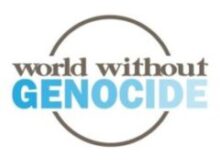Myanmar – Genocide of the Rohingya
What
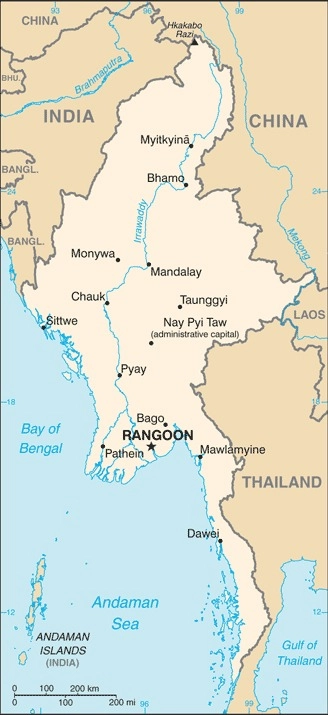
Image courtesy of The World Factbook 2021 (Central Intelligence Agency) is unmodified and located in the public domain.
Myanmar, then called Burma, achieved independence from Great Britain in 1948 and was democratic until the military seized control through a coup in 1962. [1] The armed forces, known as the Tatmadaw, established a military junta which was dissolved in 2011 amidst mass protests and international pressure. [2] While in power, the junta oppressed dissenters and ethno-religious minorities through systemic discrimination, killing protestors, and stifling freedom of speech. [3] Armed ethnic organizations have fought against Myanmar’s military government since its establishment due to persecution and a desire for autonomy. This has resulted in the world’s longest-running civil war. [4]
The military maintains significant power over the current civilian government, and human rights abuses continue. Ethnic Rohingya and Karen people are subjected to summary execution, severe torture and rape, forced labor, extortion, and displacement. [5] In 2017, Myanmar’s armed forces systematically attacked the Rohingya, killing tens of thousands, burning their villages, and displacing hundreds of thousands in a region-wide refugee crisis that observers have labeled genocide. [6]
Nearly a million Rohingya fled to Bangladesh. [7] Bangladesh refuses to take in more Rohingya. [8] Rohingya who remain in Myanmar face violence, forced internment, and severe discrimination. [9]
The Myanmar military overthrew the country’s elected government in 2021, arrested the democratically-elected leader Aung San Suu Kyi, cracked down on peaceful civilian demonstrations, refused to hold elections, and expanded attacks against civilians and ethnic minorities. [10] War continues between the Tatmadaw, anti-government armed organizations, and ethnic militias.
Where
Myanmar is the second-largest country in Southeast Asia, bordering China, Laos, Thailand, Bangladesh, and India. It features mountain ranges, highland plateaus, forests, and large rivers like the Irrawaddy, which serves much of the nation’s population. It was called Burma until 1989, when its name was changed to Myanmar. This article refers to “Burma” before 1989 and “Myanmar” after that date, although the U.S, government continues to use “Burma.” [11]
The majority of Myanmar’s 57 million people are Buddhist. [12] There are over 135 ethnic minority groups, more than 100 languages, and two-thirds of the population identifies as Bamar (Burman). [13] Major ethnic groups include the Rohingya, Kachin, Karen, Rakhine, Karenni, Mon, Shan, and Chin. Several states are majority ethnic-minority, including Rakhine State, which houses most of the country’s Muslim Rohingya minority.
When
The Pro-Democracy Movement
In 1962, a military coup overthrew Myanmar’s democratic government. Since then, the Tatmadaw has suppressed pro-democracy movements and dissent by denying food, funding, and information to those who oppose it. [14] In this country of widespread poverty, dissenters are easily co-opted into military service with promises of sufficient food; this tool has silenced much opposition.
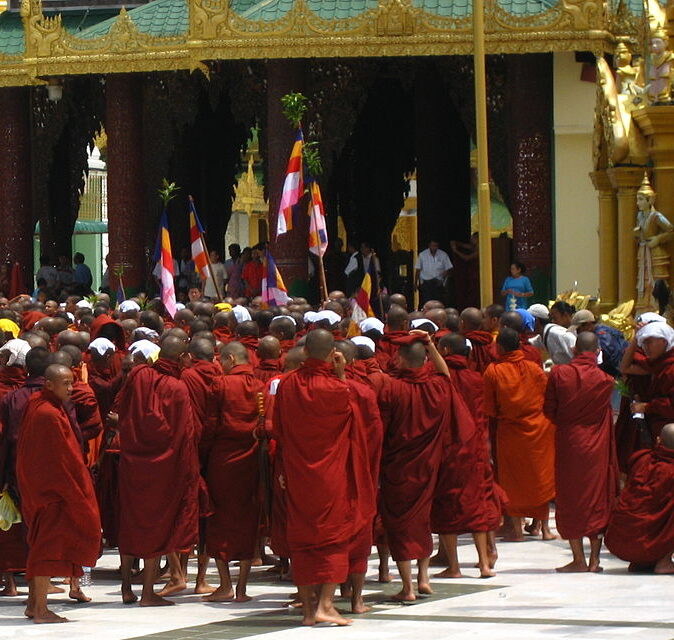
Monks protesting during Saffron Resolution in Yangon, 2007. Image courtesy of racoles is cropped and licensed under CC BY 2.0.
During widespread demonstrations in 1988, security forces arrested and killed thousands of protestors, tortured detainees, and reduced space for opposition. [15] In 1990, the government held the nation’s first free elections in almost thirty years. The National League for Democracy (NLD), led by Aung San Suu Kyi, won 392 out of 489 seats. [16] The Burmese government later annulled the results. [17] The junta placed Aung San Suu Kyi under house arrest in 2000 and sporadically held her captive for the next decade. [18]
In 2007, an anti-government movement called the “Saffron Revolution” encouraged increased freedoms. [19] Elections were held in 2010, and Tatmadaw announced that its proxy parties had won the election and 80% of governmental seats. [20] Pro-democracy groups alleged that the military committed fraud to achieve this result, and outside observers regarded the election as a sham. [21] Thein Sein, a former army official, became president the next year. Democratic elections were held in 2015, and the NLD won, led by Aung San Suu Kyi. [22] However, the military still controlled the government’s legislative and executive operations. [23]
In 2021, the military initiated a coup and re-established the governing military junta. [24] Democratic suppression ensued: the Tatmadaw imprisoned Aung San Suu Kyi again, attacked protestors, and increased persecution of political dissidents. [25] It enlarged military actions against civilians and ethnic minorities and implemented a compulsory service law. [26] Dissenters united to form the National Unity Government (NUG), a multi-ethnic coalition that declared war on the Tatmadaw. [27]
The junta declared a state of emergency in 2021 which continues today, despite promises to hold elections after the “crisis” ended. [28]
The Karen Ethnic Minority
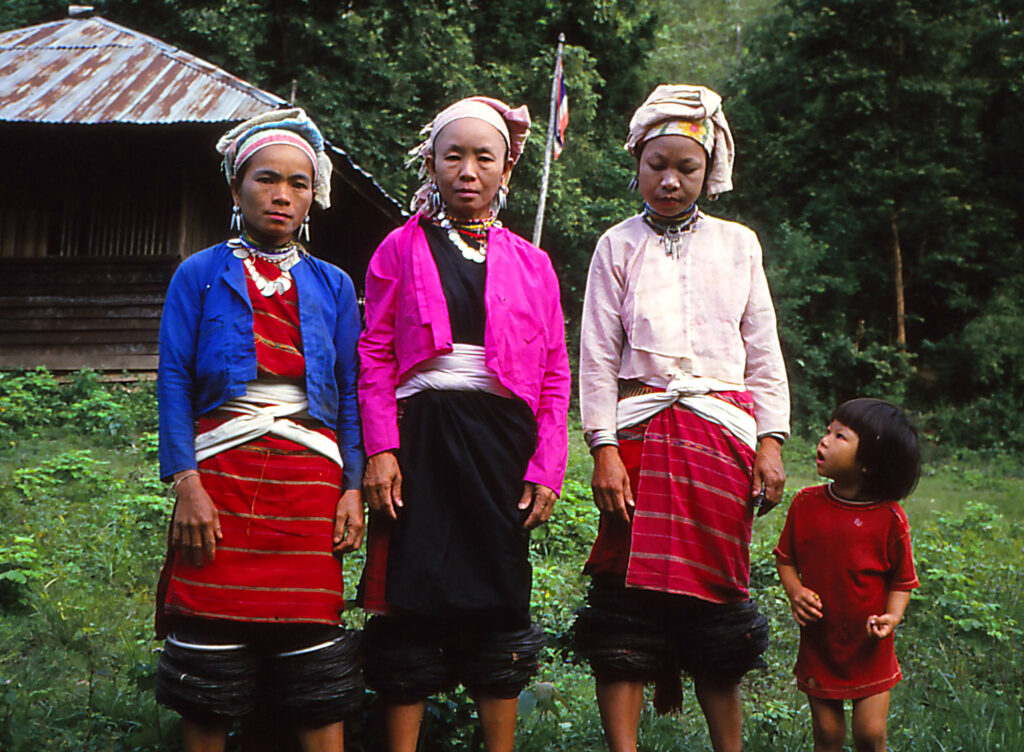
Red Karen, a subgroup of the Karen, women wearing traditional dress, 1985. Image courtesy of Linda De Volder is unmodified and licensed under CC BY-NC-ND 2.0.
During World War II, the Karen fought alongside Great Britain against the invading Japanese, who the Burmese-led government aided. [29] The Allies recaptured Burma in 1945. The Karen thought that they would earn an independent state by assisting the British, but this never happened, and the Karen have fought for independence and autonomy ever since. [30]
In their struggle to maintain power in the 1980s, the Tatmadaw tried to negotiate agreements with ethnic armed organizations inside Burma. Karen groups refused to participate and the government retaliated by launching various offensives against the Karen throughout the 1990s. [31] Over the next few decades, hundreds of thousands of Karen were displaced. [32]
Across the 2000s, the Tatmadaw burned villages, shelled communities, conducted sweeps, and implemented forced labor schemes against Karen civilians. [33] In 2012, Myanmar and Karen rebels signed a ceasefire. [34] Despite this, the government limits Karen autonomy through media suppression, attacks continue, and they face persecution due to their Christian beliefs. [35]
The Rohingya Muslims
The Rohingya are a Muslim ethnic group in Myanmar. In 2017, there were 1.1 million Rohingya in Myanmar, or approximately 4% of the nation’s population. [36]
In 1978, the Burmese military carried out killings, rape, and arson against the Rohingya, forcing 200,000 to flee. [37] Four years later, the government framed the Rohingya as “illegal immigrants” and stripped them of citizenship through the Myanmar Citizenship Law. [38] This left the Rohingya stateless, with restrictions placed on their freedom of movement, property ownership, access to education, and ability to hold public office. [39] They were later stripped of voting rights. Rohingya now need government approval to marry, have restrictions on numbers of births allowed per family, and non-Buddhist men are banned from marrying Buddhist women. [40]
In 2012, political officials, some radicalized Buddhist monks, and security forces committed mass killings and destroyed Rohingya villages. [41] They demolished thousands of homes and buildings, [42] displacing 140,000 Rohingya. [43]
In 2017, the situation escalated significantly. The Tatmadaw, with Buddhist nationalist mobs, burned hundreds of Rohingya villages and killed tens of thousands of civilians. [44] Thousands more died trying to escape by sea. [45] The Tatmadaw used mass sexual violence, targeting Rohingya men, women, and children for various forms of assault. [46] Evidence points to the genocidal intent behind these atrocities, with Burmese soldiers describing how superiors ordered them to “[k]ill all you see, whether children or adults.” [47] Many organizations and governments have labeled these crimes against the Rohingya genocide. [48]
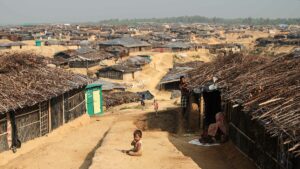
A Rohingya refugee camp in Bangladesh. Image courtesy of John Owens (VOA) is unmodified and located in the public domain.
This conflict resulted in the region’s largest refugee crisis in decades as over 700,000 Rohingya fled, mostly to Bangladesh. [49] Estimates place the number of Rohingya refugees in Bangladesh close to a million, and Bangladesh refuses to take more. [50] Life inside Bangladesh is arduous, with food, water, and medicine scarce and restrictions on movement. [51] Violence from black market gangs and human trafficking operations pervade camps and take Rohingya lives. [52] In 2020, Bangladesh forcefully relocated thousands of refugees to Bhasan Char, an isolated island prone to cyclones. [53] Repatriation efforts have made little progress. [54]
In Myanmar, dire conditions for Rohingya persist. The Tatmadaw interns hundreds of thousands within camps in Rakhine State, where inhumane conditions prevail. [55] The government failed to evacuate Rohingya when Cyclone Mocha hit the country and curbed emergency aid to them. [56] Discriminatory government policies against Rohingya continue, including forced military service. [57] The group still faces violence from the military and other ethnic armed organizations.
Myanmar recently imprisoned two Burmese journalists for seven years for investigating mass killings of Rohingya men. Many regarded the trial and harsh sentencing as a farce. Aung San Suu Kyi turned a blind eye to the issue and called the journalists “traitors” in private. [58] Suu Kyi also denied visas to United Nations human rights teams investigating the crisis and prevented international organizations from delivering aid. [59] The men were freed in 2019. [60]
Other Ethnic and Religious Minorities
Myanmar persecutes other ethnic and religious groups. Over 2 million people are internally displaced persons, many of them minorities forced to leave their homes because of armed conflict. [61] The junta has threatened to revoke the state identity cards of Kaman Muslims should they refuse to join its military, and it holds them in the same internal camps as Rohingya. [62] Since 2011, the military has systematically attacked Karenni villages, killing hundreds and arresting hundreds more. [63] Chin people have endured extrajudicial slaughter, sexual violence, evictions, and forced conversion. [64]
These are selected examples of the maltreatment that Myanmar’s non-Bamar people undergo.
How
Religious Ethno-Nationalism, Islamophobia, and Genocidal Rhetoric
Religious ethno-nationalism and Islamophobia disseminated via state and non-state propaganda incite atrocities against Rohingya and Myanmar’s other minorities. Government officials have denied Rohingya equal status as citizens across the nation’s history, demonizing them as “aliens” who seek to exploit its resources and “replace” the Bamar majority. Immense anti-Rohingya rhetoric preceded 2017’s violence. [65]
In 2012, Buddhist citizens and monks established the 969 Movement, aimed at “protecting” Myanmar’s Buddhist identity and ostracizing Rohingya people. [66] The group’s leader, Ashin Wirathu, claimed that Muslims control Myanmar’s economy, plan to forcefully convert Buddhist women, and want to transform Myanmar into an “evil Islamic nation.” [67] The government eventually banned 969, but sister organizations, like MaBaTha, still perpetuate Islamophobia. [68] Military and civilian leaders support these entities and use similar language to discuss Myanmar’s treatment of the Rohingya—Aung San Suu Kyi, for instance, refused to refer to the Rohingya by name when responding to allegations of genocide before the International Court of Justice (ICJ). [69] State-run newspapers publish anti-Rohingya articles. [70]
Facebook provides the most potent forum for spreading this hatred. Anti-Rohingya figures use the site to share misinformation about the Rohingya, deny junta atrocities, and support violence. [71] The website’s algorithms popularize this content, enabling and inciting genocide. [72]
Land Appropriation
The Tatmadaw’s desire for economic gain also motivates violence. Resource-rich land blankets Myanmar’s ethnic states and the junta appropriates these regions through force. Under a so-called privatization effort in the 2000s, the state took millions of acres of land from Shan, Kachin, and other groups and built pipelines and other infrastructure on minority properties without consent. [73] Former Rohingya villages were converted to settlements for government forces following Rohingyas’ 2017 expulsions, and similar efforts continue today. [74]
Even where ethnic minorities remain on their land as it is exploited, the government retains full control over the project and denies payment to residents. [75] Ineffective safety regulations contribute to environmental disasters like landslides, which take hundreds of lives. [76]
Government Denial
Aung San Suu Kyi was known for her democratic advocacy, but she has not stood up for minority rights as Myanmar’s leader. Suu Kyi blamed the violence in Myanmar on “terrorist activities, which was the initial cause of events leading to the humanitarian crisis,” and denied violence against Rohingya, either denying its existence or repeating propaganda about the group. [77]
Several organizations revoked awards given to Aung San Suu Kyi because of her inaction on the persecution of the Rohingya. The United States Holocaust Memorial Museum withdrew the Elie Wiesel Award that it presented to Suu Kyi in 2012, citing her refusal to stop or condemn the mass killings of the Rohingya. [78] In 2018, the Canadian House of Commons declared the Rohingya crisis a genocide and stripped Suu Kyi of her honorary Canadian citizenship. [79] She was formally deprived of the Freedom of the City of Oxford Award, Freedom of Dublin Award, and Freedom of Glasgow Award. [80] A global petition campaign with over 400,000 signatories called on the Nobel Committee to rescind Suu Kyi’s Nobel Peace Prize, but the Committee deemed a retraction impossible. [81]
Other government officials and general citizens in Myanmar practice total denial.
Response
Various nations and organizations have implemented sanctions against Myanmar. [82] Australia, the United Kingdom the European Union, and the United States impose financial penalties on the Burmese government and individual perpetrators. [83] In 2022, the UN Security Council passed Resolution 2669, calling for an end to violence within Myanmar and steps to address the Rohingyas’ plight. [84]
In October 2017, the US withdrew military assistance to Myanmar after the Rohingya crisis began, and a month later, Secretary of State Rex Tillerson declared the violence against the Rohingya to be ethnic cleansing. [86] The U.S. government has since declared Myanmar’s persecution of the Rohingya a genocide. [87]
On August 25, 2018, the UN reported that the Tatmadaw’s actions against the Rohingya “undoubtedly amount[ed] to the gravest crimes under international law.” [88] It urged an international court to bring Myanmar’s army commander and five other top generals to trial for genocide. [89]
In 2019, the International Criminal Court (ICC) approved investigations of violence perpetrated against the Rohingya for crimes against humanity charges. [90] The Gambia filed a case against Myanmar at the International Court of Justice (ICJ) for genocide against the Rohingya. [91]
In 2020, the ICJ issued provisional measures, ordering Myanmar to take all possible measures to protect the remaining 600,000 Rohingya Muslims from genocide. [92] While the ruling is binding, no enforcement mechanism exists. [93]
Under the doctrine of universal jurisdiction, Argentina’s federal courts opened a case in 2019 of genocide against the leaders of Myanmar. [94] In 2024, an Argentine prosecutor asked the Buenos Aires federal court to issue international arrest warrants for 24 Burmese leaders accused of committing genocide against the Rohingya. [95]
Future
Civil war continues and the Tatmadaw is accused of human rights abuses. No ceasefire attempt has been successful. [96]
Rohingya filed lawsuits against Facebook, seeking damages for their role in the genocide. These cases had mixed success, and they continue today. [97] For more on the role of social media and Facebook’s culpability in Myanmar read here.
The Gambia’s ICJ suit against Myanmar slowly advances. In 2023, the Maldives, France, Germany, Canada, Denmark, the Netherlands, and the UK submitted declarations to intervene on the side of The Gambia in the dispute. [98] Myanmar is due to file its counter-arguments before the ICJ by the end of 2024, likely initiating the case’s next stages. [99]
Updated by Bekir Hodzic, October 2024.
References
[1] Myanmar country profile. (2023, May 26). BBC News. https://www.bbc.com/news/world-asia-pacific-12990563
[2] Marston, H. (2021, February 2). Analysis: Why is Myanmar’s military so powerful? Al Jazeera. https://www.aljazeera.com/features/2021/2/2/analysis-why-is-myanmar-military-so-powerful
[3] Maizland, L. (2022, January 31). Myanmar’s Troubled History: Coups, Military Rule, and Ethnic Conflict. Council on Foreign Relations. https://www.cfr.org/backgrounder/myanmar-history-coup-military-rule-ethnic-conflict-rohingya
[4] Sun, Y. (2023, February 13). The civil war in Myanmar: No end in sight. Brookings. https://www.brookings.edu/articles/the-civil-war-in-myanmar-no-end-in-sight/
[5] Ritinsky, G. (2019, September 28). Rohingya, Kachin, Karen… to name but a few. United World Project. https://www.unitedworldproject.org/en/watch/rohingya-kachin-karen-to-name-but-a-few/
[6] Genocide, Crimes Against Humanity and Ethnic Cleansing of Rohingya in Burma. (n.d.). U.S. Department of State. https://www.state.gov/burma-genocide/
[7] Rohingya Refugees in Bangladesh: Limiting the Damage of a Protracted Crisis. (2023, October 4). International Crisis Group. https://www.crisisgroup.org/asia/south-east-asia/myanmar-bangladesh/rohingya-refugees-bangladesh-limiting-damage-protracted
[8] Paul, R. & Ganguly, S. (2024, February 7). Bangladesh will not let in any more Rohingya refugees – minister. Reuters. https://www.reuters.com/world/asia-pacific/bangladesh-will-not-let-any-more-rohingya-refugees-minister-2024-02-07/
[9] van den Assum, L. (2024, September 25). Out of the Spotlight, Myanmar’s Rohingya Face Worst Violence in 7 Years. United States Institute of Peace. https://www.usip.org/publications/2024/09/out-spotlight-myanmars-rohingya-face-worst-violence-7-years#:~:text=The%20world%20has%20known%20about,on%20the%20global%20Rohingya%20community
[10] Paddock, R. C. (2022, December 9). Myanmar’s Coup and Its Aftermath, Explained. The New York Times. https://www.nytimes.com/article/myanmar-news-protests-coup.html
[11] Tong-Hyung, K. & Kim, H. (2021, February 2). Myanmar, Burma and why the different names matter. AP News. https://apnews.com/article/myanmar-burma-different-names-explained-8af64e33cf89c565b074eec9cbe22b72
[12] Central Intelligence Agency. (2024, October 1). Burma. The World Factbook. https://www.cia.gov/the-world-factbook/countries/burma/
[13] A Brief Overview of the Ethnic Minorities of Burma. (2021, February 8). Humanitarian Aid Relief Trust. https://www.hart-uk.org/a-brief-overview-of-the-ethnic-minorities-of-burma/
[14] Maizland, L. (2022, January 31). Myanmar’s Troubled History: Coups, Military Rule, and Ethnic Conflict. Council on Foreign Relations. https://www.cfr.org/backgrounder/myanmar-history-coup-military-rule-ethnic-conflict-rohingya
[15] Head, J. (2021, March 15). Myanmar coup: What protesters can learn from the ‘1988 generation’. BBC. https://www.bbc.com/news/world-asia-56331307
[16] Guyot, J. F. (1991). Myanmar in 1990: The Unconsummated Election. Asian Survey, 31(2), 205–211. https://www.jstor.org/stable/2644932?searchText=&searchUri=&ab_segments=&searchKey=&refreqid=fastly-default%3A48bc5ea2e03d42974f9d3f604d092b9a&seq=1
[17] Reuters. (2010, March 11). Myanmar junta annuls election held 20 years ago. Reuters. https://www.reuters.com/article/us-myanmar-election/myanmar-junta-annuls-election-held-20-years-ago-idUSTRE62A15L20100311/?edition-redirect=uk
[18] Burma: Chronology of Aung San Suu Kyi’s Detention. (2010, November 13). Human Rights Watch. https://www.hrw.org/news/2010/11/13/burma-chronology-aung-san-suu-kyis-detention
[19] Freeman, J. (2017, September 29). The ‘Good Monk’ Myth. The Atlantic. https://www.theatlantic.com/international/archive/2017/09/saffron-revolution-good-monk-myth/541116/
[20] Reuters in Rangoon. (2010, November 9). Burmese election won by military-backed party. The Guardian. https://www.theguardian.com/world/2010/nov/09/burma-usdp-wins-election
[21] Reuters in Rangoon. (2010, November 9). Burmese election won by military-backed party. The Guardian. https://www.theguardian.com/world/2010/nov/09/burma-usdp-wins-election
[22] Myanmar’s 2015 landmark elections explained. (2015, December 3). BBC News. https://www.bbc.com/news/world-asia-33547036
[23] Maizland, L. (2022, January 31). Myanmar’s Troubled History: Coups, Military Rule, and Ethnic Conflict. Council on Foreign Relations. https://www.cfr.org/backgrounder/myanmar-history-coup-military-rule-ethnic-conflict-rohingya
[24] Ratcliffe, R. (2022, September 18). The 2021 Myanmar coup explained in 30 seconds. The Guardian. https://www.theguardian.com/world/2022/sep/19/myanmar-coup-2021-explained-in-30-seconds
[25] Myanmar: Year of Brutality in Coup’s Wake. (2022, January 28). Human Rights Watch. https://www.hrw.org/news/2022/01/28/myanmar-year-brutality-coups-wake
[26] Myanmar’s Coup Shakes Up Its Ethnic Conflicts. (2022, January 12). International Crisis Group. https://www.crisisgroup.org/asia/south-east-asia/myanmar/myanmars-coup-shakes-its-ethnic-conflicts; Hein, Y. M. (2024, February 26). Myanmar’s Fateful Conscription Law. United States Institute of Peace. https://www.usip.org/publications/2024/02/myanmars-fateful-conscription-law
[27] Beech, H. (2023, November 13). Fighting to Govern Myanmar, From a Teeny Office in Washington. The New York Times. https://www.nytimes.com/2023/11/13/world/asia/myanmar-national-unity-government-coup-rohingya.html
[28] RFA Burmese. (2024, August 26). Myanmar junta commits to staggered 2025 election. Radio Free Asia. https://www.rfa.org/english/news/myanmar/election-2025-08262024083618.html
[29] Karen in Myanmar. (2017, August). Minority Rights Group. https://minorityrights.org/communities/karen/
[30] Karen in Myanmar. (2017, August). Minority Rights Group. https://minorityrights.org/communities/karen/
[31] Burma/Karens (1948-present). (n.d.). University of Central Arkansas. https://uca.edu/politicalscience/home/research-projects/dadm-project/asiapacific-region/burmakarens-1948-present/
[32] South, A. (2007, February). Burma: The Changing Nature of Displacement Crises. Refugee Studies Centre. (Working Paper No. 39). https://www.rsc.ox.ac.uk/files/files-1/wp39-burma-changing-nature-displacement-crises-2007.pdf
[33] Human Rights Watch. (2005, January 9). “They Came and Destroyed Our Village Again”: The Plight of Internally Displaced Persons in Karen State. Human Rights Watch. https://www.hrw.org/report/2005/06/09/they-came-and-destroyed-our-village-again/plight-internally-displaced-persons
[34] Burma government signs ceasefire with Karen rebels. (2012, January 12). BBC News. https://www.bbc.com/news/world-asia-16523691
[35] Fleming, R. (2016, December). Hidden Plight: Christian Minorities in Burma. U.S. Commission of International Religious Freedom. https://www.uscirf.gov/sites/default/files/Hidden%20Plight.%20Christian%20Minorities%20in%20Burma.pdf
[36] Al Jazeera Staff. (2018, April 18). Who are the Rohingya? Al Jazeera. https://www.aljazeera.com/features/2018/4/18/who-are-the-rohingya
[37] Crimes Against Humanity in Myanmar. (2019, May 15). Amnesty International. https://www.amnestyusa.org/blog/crimes-against-humanity-in-myanmar/crimes-against-humanity-in-myanmar/
[38] Johar, A. (2021, November 9). Myanmar’s discriminatory citizenship law: are Rohingyas the only victims? Migration Mobilities Bristol. https://migration.bristol.ac.uk/2021/11/09/myanmars-discriminatory-citizenship-law-are-rohingyas-the-only-victims/
[39] Human Rights Watch. (2013, April 22). “All You Can Do is Pray”: Crimes Against Humanity and Ethnic Cleansing of Rohingya Muslims in Burma’s Arakan State. Human Rights Watch. https://www.hrw.org/report/2013/04/22/all-you-can-do-pray/crimes-against-humanity-and-ethnic-cleansing-rohingya-muslims
[40] Albert, E. & Maizland, L. (2020, January 23). The Rohingya Crisis. Council on Foreign Relations. https://www.cfr.org/backgrounder/rohingya-crisis; 2023 Country Reports on Human Rights Practices: Burma. (n.d.). U.S. Department of State. https://www.state.gov/reports/2023-country-reports-on-human-rights-practices/burma-draft/
[41] Human Rights Watch. (2013, April 22). “All You Can Do is Pray”: Crimes Against Humanity and Ethnic Cleansing of Rohingya Muslims in Burma’s Arakan State. Human Rights Watch. https://www.hrw.org/report/2013/04/22/all-you-can-do-pray/crimes-against-humanity-and-ethnic-cleansing-rohingya-muslims
[42] Myanmar violence displaces thousands (2012, October 28). Al Jazeera. https://www.aljazeera.com/news/2012/10/28/myanmar-violence-displaces-thousands
[43] Hollingsworth, A. (2015, November 17). Malaysia: Rohingya Refugees Hope for Little and Receive Less. Refugees International. https://www.refugeesinternational.org/reports-briefs/malaysia-rohingya-refugees-hope-for-little-and-receive-less/
[44] Lone, W., Oo, K. S., Lewis, S. & Slodkowski, A. (2018, February 8). How Myanmar forces burned, looted and killed in a remote village. Reuters. https://www.reuters.com/investigates/special-report/myanmar-rakhine-events/; Human Rights Watch. (2017, December 19). Massacre by the River: Burmese Army Crimes against Humanity in Tula Toli. Human Rights Watch. https://www.hrw.org/report/2017/12/19/massacre-river/burmese-army-crimes-against-humanity-tula-toli; Condon, G. (2022, October 19). Myanmar Genocide Emergency. Genocide Watch. https://www.genocidewatch.com/single-post/genocide-emergency-myanmar
[45] Das, K. N. & Paul, R. (2022, December 26). Deadliest year for Rohingya at sea in years as 180 presumed drowned. Reuters. https://www.reuters.com/world/asia-pacific/deadliest-year-rohingya-sea-years-180-presumed-drowned-2022-12-26/
[46] Human Rights Watch. (2017, November 16). “All of My Body Was Pain”: Sexual Violence against Rohingya Women and Girls in Burma. Human Rights Watch. https://www.hrw.org/report/2017/11/16/all-my-body-was-pain/sexual-violence-against-rohingya-women-and-girls-burma; Hölzl, V. (2019, September 4). Male rape survivors go uncounted in Rohingya camps. The New Humanitarian. https://www.thenewhumanitarian.org/news-feature/2019/09/04/Rohingya-men-raped-Myanmar-Bangladesh-refugee-camps-GBV
[47] Beech, H., Nang, S. & Simons, M. (2021, October 19). ‘Kill All You See’: In a First, Myanmar Soldiers Tell of Rohingya Slaughter. The New York Times. https://www.nytimes.com/2020/09/08/world/asia/myanmar-rohingya-genocide.html
[48] Stanton, G. H. (2017, September 18). Persecution, Forced Displacement, and Genocide of Rohingya, Kachin, Shan, Karen and Other Minorities. Genocide Watch. https://www.genocidewatch.com/single-post/2017/09/18/persecution-forced-displacement-and-genocide-of-rohingya-kachin-shan-karen-and-other-mino
[49] Rohingya refugee crisis. (2024, August 21). Doctors Without Borders. https://www.doctorswithoutborders.org/what-we-do/focus/rohingya-refugee-crisis
[50] Paul, R. & Ganguly, S. (2024, February 7). Bangladesh will not let in any more Rohingya refugees – minister. Reuters. https://www.reuters.com/world/asia-pacific/bangladesh-will-not-let-any-more-rohingya-refugees-minister-2024-02-07/
[51] Human Rights Watch. (2022, April 4). Bangladesh: New Restrictions on Rohingya Camps. Human Rights Watch. https://www.hrw.org/news/2022/04/04/bangladesh-new-restrictions-rohingya-camps
[52] Ethirajan, A. (2023, August 24). Rohingya: Gang violence stalks world’s largest refugee camp. BBC. https://www.bbc.com/news/world-asia-66569013
[53] Human Rights Watch. (2021, June 7). “An Island Jail in the Middle of the Sea”: Bangladesh’s Relocation of Rohingya Refugees to Bhasan Char. Human Rights Watch. https://www.hrw.org/report/2021/06/07/island-jail-middle-sea/bangladeshs-relocation-rohingya-refugees-bhasan-char
[54] Saha, K. K. (2023, June 7). Rohingya Repatriation: Caught between State Failure and Armed Resistance. Institute of Peace and Conflict Studies. https://www.ipcs.org/comm_select.php?articleNo=5852
[55] Human Rights Watch. (2020, October 8). Myanmar: Mass Detention of Rohingya in Squalid Camps. Human Rights Watch. https://www.hrw.org/news/2020/10/08/myanmar-mass-detention-rohingya-squalid-camps
[56] Bauchner, S. (2023, May 18). Cyclone Mocha Devastates Myanmar’s Rohingya. Human Rights Watch. https://www.hrw.org/news/2023/05/18/cyclone-mocha-devastates-myanmars-rohingya
[57] Head, J. & BBC Burmese. (2024, April 7). Myanmar’s army massacred Rohingyas. Now it wants their help. BBC. https://www.bbc.com/news/world-asia-68730994
[58] Agence France-Presse. (2018, September 4). As Myanmar Jails Reuters Journalists, Aung San Suu Kyi’s Image In Shreds. NDTV World. https://www.ndtv.com/world-news/suu-kyis-image-in-shreds-as-myanmar-jails-reuters-pair-1910549
[59] Beech, H. (2017, September 25). What Happened to Myanmar’s Human-Rights Icon? The New Yorker. https://www.newyorker.com/magazine/2017/10/02/what-happened-to-myanmars-human-rights-icon
[60] Lewis, S. & Naing, S. (2019, May 7). Two Reuters reporters freed in Myanmar after more than 500 days in jail. Reuters. https://www.reuters.com/article/world/two-reuters-reporters-freed-in-myanmar-after-more-than-500-days-in-jail-idUSKCN1SD057/
[61] Myanmar. (n.d.). Internal Displacement Monitoring Centre. https://www.internal-displacement.org/countries/myanmar/#:~:text=Around%202.9%20million%20people%20were,violence%20and%20235%2C000%20by%20disasters
[62] Human Rights Watch. (2020, October 8). Myanmar: Mass Detention of Rohingya in Squalid Camps. Human Rights Watch. https://www.hrw.org/news/2020/10/08/myanmar-mass-detention-rohingya-squalid-camps
[63] Corritti, A., Mie, M., Matthias & Banya, K. (2023, March 1). Atrocities in Myanmar: Documenting the Junta’s Attacks on Civilians. United States Institute of Peace. https://www.usip.org/publications/2023/03/atrocities-myanmar-documenting-juntas-attacks-civilians
[64] Chin in Myanmar. (2017, August). Minority Rights Group. https://minorityrights.org/communities/chin/#:~:text=The%20Chin%20appear%20to%20have,were%20physical%20attacks%20on%20pastors
[65] Win, K. (2015, September 15). The root cause of Rohingya persecution. New Mandala. https://www.newmandala.org/the-root-cause-of-rohingya-persecution/
[66] Beech, H. (2013, July 1). The Face of Buddhist Terror. Time. https://time.com/archive/6643742/the-face-of-buddhist-terror/
[67] Bookbinder, A. (2013, April 9). 969: The Strange Numerological Basis for Burma’s Religious Violence. The Atlantic. https://www.theatlantic.com/international/archive/2013/04/969-the-strange-numerological-basis-for-burmas-religious-violence/274816/
[68] Buddhism and State Power in Myanmar. (2017, September 5). International Crisis Group. https://www.crisisgroup.org/asia/south-east-asia/myanmar/290-buddhism-and-state-power-myanmar
[69] Marshall, A. R. C. (2013, June 27). Special Report: Myanmar gives official blessing to anti-Muslim monks. Reuters. https://www.reuters.com/article/world/special-report-myanmar-gives-official-blessing-to-anti-muslim-monks-idUSBRE95Q04F/; Safdar, A. & Siddiqui, U. (2019, December 13). ICJ speech: Suu Kyi fails to use ‘Rohingya’ to describe minority. Al Jazeera. https://www.aljazeera.com/news/2019/12/13/icj-speech-suu-kyi-fails-to-use-rohingya-to-describe-minority
[70] Burma’s Path to Genocide: Chapter III: Weakened. (n.d.). United States Holocaust Memorial Museum. https://exhibitions.ushmm.org/burmas-path-to-genocide/chapter-3/weakened
[71] Amnesty International. (2022, September 29). Myanmar: Facebook’s Systems Promoted Violence Against Rohingya; Meta Owes Reparations. Amnesty International. https://www.amnesty.org/en/latest/news/2022/09/myanmar-facebooks-systems-promoted-violence-against-rohingya-meta-owes-reparations-new-report/
[72] Amnesty International. (2022, September 29). Myanmar: Facebook’s Systems Promoted Violence Against Rohingya; Meta Owes Reparations. Amnesty International. https://www.amnesty.org/en/latest/news/2022/09/myanmar-facebooks-systems-promoted-violence-against-rohingya-meta-owes-reparations-new-report/
[73] Heijmans, P. (2015, March 28). Report: Myanmar officials conspired to steal land. Al Jazeera. https://www.aljazeera.com/news/2015/3/28/report-myanmar-officials-conspired-to-steal-land; Anwary, A. (2023). Displacement of the Rohingyas of Myanmar, Land Grabbing, and Extractive Capital. Journal of Social Encounter, 7(1), 26-48. https://digitalcommons.csbsju.edu/cgi/viewcontent.cgi?article=1160&context=social_encounters
[74] Head, J. (2019, September 9). Rohingya crisis: Villages destroyed for government facilities. BBC. https://www.bbc.com/news/world-asia-49596113
[75] Fishbein, E. & Naw, S. (2020, August 19). After Another Mining Disaster, Ethnic Minorities Lose Patience With Myanmar’s Leadership. Foreign Policy. https://foreignpolicy.com/2020/08/19/jade-mining-disaster-ethnic-minorities-lose-patience-myanmar-leadership-aung-san-suu-kyi-peace-process/
[76] Fishbein, E. & Naw, S. (2020, August 19). After Another Mining Disaster, Ethnic Minorities Lose Patience With Myanmar’s Leadership. Foreign Policy. https://foreignpolicy.com/2020/08/19/jade-mining-disaster-ethnic-minorities-lose-patience-myanmar-leadership-aung-san-suu-kyi-peace-process/
[77] Beech, H. (2018, August 25). Year After Rohingya Massacres, Top Generals Unrepentant and Unpunished. The New York Times. https://www.nytimes.com/2018/08/25/world/asia/rohingya-myanmar-ethnic-cleansing-anniversary.html
[78] Smith, D. (2018, March 7). US Holocaust Museum withdraws Aung San Suu Kyi’s human rights award. The Guardian. https://www.theguardian.com/world/2018/mar/07/aung-san-suu-kyi-holocaust-museum-award
[79] Carbert, M. & Curry, B. (2018, September 27). In unprecedented move, Commons passes motion to strip Suu Kyi’s honorary citizenship. The Globe and Mail. https://www.theglobeandmail.com/politics/article-house-of-commons-unanimously-passes-motion-to-strip-aung-san-suu-kyis/
[80] Grierson, J. (2017, October 4). Aung San Suu Kyi to be stripped of Freedom of the City of Oxford.The Guardian. https://www.theguardian.com/uk-news/2017/oct/04/aung-san-suu-kyi-to-be-stripped-of-freedom-of-the-city-of-oxford; Barron, L. (2017, December 14). Dublin Revokes Aung San Suu Kyi’s Prestigious Freedom of City Award. Time. https://time.com/5063948/aung-san-suu-kyis-freedom-of-dublin/; Myanmar leader Aung San Suu Kyi stripped of freedom of Glasgow. (2017, November 3). BBC. https://www.bbc.com/news/uk-scotland-glasgow-west-41858791
[81] Westcott, B. & Watson, A. (2018, August 29). Aung San Suu Kyi will not be stripped of Nobel Prize, committee says. CNN. https://www.cnn.com/2018/08/29/asia/aung-san-suu-kyi-nobel-prize-intl/index.html
[82] Burma Sanctions. (n.d.). U.S. Department of State. https://www.state.gov/burma-sanctions/
[83] Caine, K., Fardelmann, K., McDougall, K., Nattrass, S. & Gollish, S. (2021, April 26). New sanctions and export restrictions imposed targeting Burma. Norton Rose Fulbright. https://www.nortonrosefulbright.com/en-us/knowledge/publications/ac28ff93/new-sanctions-and-export-restrictions-imposed-targeting-burma
[84] Security Council Demands Immediate End to Violence in Myanmar, Urges Restraint, Release of Arbitrarily Detained Prisoners, Adopting Resolution 2669 (2022). (2022, December 21). United Nations. https://press.un.org/en/2022/sc15159.doc.htm
[85] Paing, T. A. (2024, August 26). China in Myanmar: How the Game-Changing Neighbor Would Continue to Maintain Its Influence. Stimson Center. https://www.stimson.org/2024/china-in-myanmar-how-the-game-changing-neighbor-would-continue-to-maintain-its-influence/
[86] Myanmar Rohingya crisis: US withdraws military assistance. (2017, October 24). BBC. https://www.bbc.com/news/world-asia-41731108; Gramer, R. (2017, November 22). Tillerson Finally Brands Myanmar Crisis ‘Ethnic Cleansing’. Foreign Policy. https://foreignpolicy.com/2017/11/22/tillerson-finally-brands-myanmar-crisis-ethnic-cleansing-rohingya-muslims-war-crimes-genocide-state-department-asia-refugees/
[87] Human Rights Watch. (2022, March 21). Myanmar: US Recognizes Genocide Against Rohingya. Human Rights Watch. https://www.hrw.org/news/2022/03/21/myanmar-us-recognizes-genocide-against-rohingya
[88] Cumming-Bruce, N. (2018, August 27). Myanmar Generals Should Face Genocide Charges Over Rohingya, U.N. Says. The New York Times. https://www.nytimes.com/2018/08/27/world/asia/myanmar-rohingya-genocide.html?smprod=nytcore-ipad&smid=nytcore-ipad-share
[89] Cumming-Bruce, N. (2018, August 27). Myanmar Generals Should Face Genocide Charges Over Rohingya, U.N. Says. The New York Times. https://www.nytimes.com/2018/08/27/world/asia/myanmar-rohingya-genocide.html?smprod=nytcore-ipad&smid=nytcore-ipad-share
[90] Information for victims: Bangladesh/Myanmar. (n.d.). International Criminal Court. https://www.icc-cpi.int/victims/bangladesh-myanmar
[91] Application of the Convention on the Prevention and Punishment of the Crime of Genocide (The Gambia v. Myanmar: 7 States intervening). (n.d.). International Court of Justice. https://www.icj-cij.org/case/178
[92] Rist, D. W. (2020, February 27). What Does the ICJ Decision on The Gambia v. Myanmar Mean?American Society of International Law: ASIL Insights. https://www.asil.org/insights/volume/24/issue/2/what-does-icj-decision-gambia-v-myanmar-mean
[93] Brody, R. & Goodman, A. (2020, January 27). International Court of Justice Orders Burmese Authorities to Protect Rohingya Muslims from Genocide: Interview with Reed Brody. Human Rights Watch. https://www.hrw.org/news/2020/01/27/international-court-justice-orders-burmese-authorities-protect-rohingya-muslims
[94] Hamann, C. G. (2023, June 7). Argentine court hears allegations of genocide against Myanmar leaders. Radio Free Asia. https://www.rfa.org/english/news/myanmar/rohingya-argentina-06072023162250.html
[95] Buzo, E., Brown, C., Gibson, K. & Conradsen, P. (2024, July 16). Argentinian Arrest Warrants for Crimes against the Rohingya: The Power of Small States. OpinioJuris. http://opiniojuris.org/2024/07/16/argentinian-arrest-warrants-for-crimes-against-the-rohingya-the-power-of-small-states/
[96] The Nationwide Ceasefire Agreement in Myanmar: The Time for Reflection and New Solutions. (2023, October 15). Transnational Institute. https://www.tni.org/en/article/the-nationwide-ceasefire-agreement-in-myanmar
[97] Crystal, C. (2023, September 7). Facebook, Telegram, and the Ongoing Struggle Against Online Hate Speech. Carnegie Endowment for Peace. https://carnegieendowment.org/research/2023/09/facebook-telegram-and-the-ongoing-struggle-against-online-hate-speech?lang=en
[98] Basch, S. (2024, July 10). ICJ Allows Seven Nations to Intervene in Rohingya Genocide Case.American Society of International Law. https://www.asil.org/ILIB/icj-allows-seven-nations-intervene-rohingya-genocide-case#:~:text=The%20ICJ%20has%20allowed%20seven,Myanmar%20brought%20by%20the%20Gambia
[99] Rahman, H. (2024, May 24). Justice Delayed Is Justice Denied: When Will the Rohingya Genocide Case Be Resolved? The Diplomat. https://thediplomat.com/2024/05/justice-delayed-is-justice-denied-when-will-the-rohingya-genocide-case-be-resolved/
